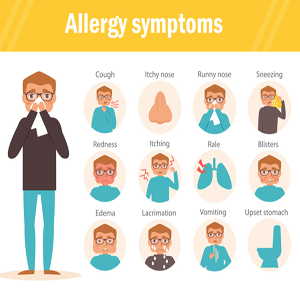
Allergy isn’t really a disease. It’s a mechanism that can be present in some illnesses – the so-called “allergic diseases”. So, “allergy” per se doesn’t have symptoms; the disease itself does.
Common allergic diseases include asthma, eczema, rhinitis, hives, insect allergies, food allergies, drug allergies and anaphylaxis. Many of these diseases can have both allergic and non-allergic “versions”. For example, a reaction to insect bites may be an allergy or a toxic reaction.
Food reactions could be allergies, aversions, intolerances or poisoning. There are also both allergic and non-allergic subtypes of asthma and rhinitis.
Asthma symptoms
Symptoms of asthma include recurrent tight chest, as well as wheezing and/or coughing. Coughing is usually prominent in the early hours of the morning, especially between 1am and 2am, and doesn’t produce sputum.
Asthma symptoms are often associated with the common cold (or other upper respiratory tract infections), but may also be triggered by exercise (particularly in cold and dry weather), laughter, crying, and exposure to allergens and irritants such as cigarette smoke, petrol or paint fumes.
There may be a seasonal variation in symptoms and a variation in symptoms throughout the day. Symptoms may wake you up in the early hours of the morning, or you may experience increased symptoms when you get out of bed.
Asthma symptoms are reversible with an asthma pump or a nebuliser.
Allergic rhinitis symptoms
Symptoms of allergic rhinitis (hay fever) include:
• Blocked nose
• Itchy or runny nose
• Sneezing
• Red, itchy eyes
• Unusual sounds such as persistent sniffing, snorting or clicking noises
• An itchy throat and/or ears
• Trouble sleeping
Eczema symptoms
A typical eczema-type rash, which comes and goes, is always itchy, and can be acute or chronic. The acute rash is red, swollen and often accompanied by a yellowish ooze, while the chronic rash is thick and darker than normal skin.
The rash usually starts in infancy and changes its distribution as a child develops. It typically first affects the cheeks and chin, later the outsides of the arms and knees, and later the insides (flexures) of the arms and knees.
Symptoms of urticaria (hives/bommels)
Symptoms include a raised rash that’s itchy but not painful.
Urticaria usually lasts less than three days and heals without leaving a change in colour of the skin. It tends to shift across the body, and can occur on its own (spontaneously) or be triggered by specific physical or allergic triggers.
Symptoms of food, insect and drug allergies
These include:
• Swelling of the skin, lips, tongue or face
• Itchy skin, hives or eczema
• Wheezing or noisy breathing
• Tightness of the throat with coughing or voice change
• Nausea or vomiting
• Diarrhoea
• Stuffy or runny nose, or sneezing
• Dizziness
• A drop in blood pressure
• Rapid pulse
• Trouble swallowing
• Difficulty breathing
• Loss of consciousness
Reviewed by Prof Mike Levin, Head of Division of Asthma and Allergy at the University of Cape Town: MBChB; FCPaed; MMed; PhD Diploma Allergology; EAACI UEMS Exam in Allergy. FAAAAI, FACAAI. March 2018
Image credit: iStock




 Publications
Publications
 Partners
Partners
















